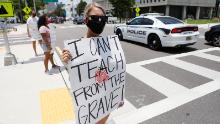US Coronavirus: Covid-19 deaths should start dropping across US by next week, CDC chief says
Mitigation measures like controlling crowds and shutting down bars work, CDC Director Dr. Robert Redfield said Thursday, but it takes time until they’re reflected in the numbers.
“It is important to understand these interventions are going to have a lag, that lag is going to be three to four weeks,” Redfield said in an interview with the Journal of the American Medical Association. “Hopefully this week and next week you’re going to start seeing the death rate really start to drop.”
But Redfield warned that while officials have observed cases fall across red zones in the country, cases in yellow zones across the heart of the US aren’t falling.
“Middle America right now is getting stuck,” he said. “That is why it’s so important for Middle America to recognize the mitigation that we talked about … it’s for Middle America too, the Nebraskas, the Oklahomas.”
“We don’t need to have a third wave in the heartland right now,” he said. “We need to prevent that.”
Superspeading events help drive pandemic
Biostatistician Max Lau of Emory University and a team analyzed Georgia health department data in more than 9,500 Covid-19 cases in four metro Atlanta-area counties and Dougherty County in rural southwestern Georgia between March and May.
“Overall, about 2% of cases were directly responsible for 20% of all infections,” they wrote in their report.
“Spread is primarily, we’re seeing in social situations, family gatherings where people are unmasked, and in close contact and basically let their guard down,” Ohio Gov. Mike DeWine said Thursday.
Up to 60 million Americans likely infected
Experts have for long said the true number of infections throughout the country is likely many times higher than the cases reported.
On Thursday, Redfield said as many as 60 million Americans could have contracted the virus — more than 10 times the number of cases recorded.
“I think if you’re going to do a crude estimate, somewhere between 30 and 60 million people — but let’s let the data come out and see what the data shows,” he said.
There are many reasons behind why the number of true infections remain uncertain.
White House declares teachers essential workers
Meanwhile, amid a turbulent back-to-school season the White House made a new push for a return to education normalcy.
Under Department of Homeland Security guidance issued this week, teachers are now considered “critical infrastructure workers,” and are subject to the same kinds of advisories as other workers who have born that label — such as doctors and law enforcement officers.
Guidance for essential workers state they can continue to work even after exposed to a confirmed case of the virus, as long as they remain asymptomatic.
Across the US, institutions have been torn between remote instruction or implementing dozens of new measures to prevent virus clusters around in-person learning. Many teachers have protested a return to in-person instruction, saying doing so could prove deadly. Some have opted to resign instead of going back to class amid the pandemic.
CNN’s Sarah Westwood and Shelby Lin Erdman contributed to this report.








